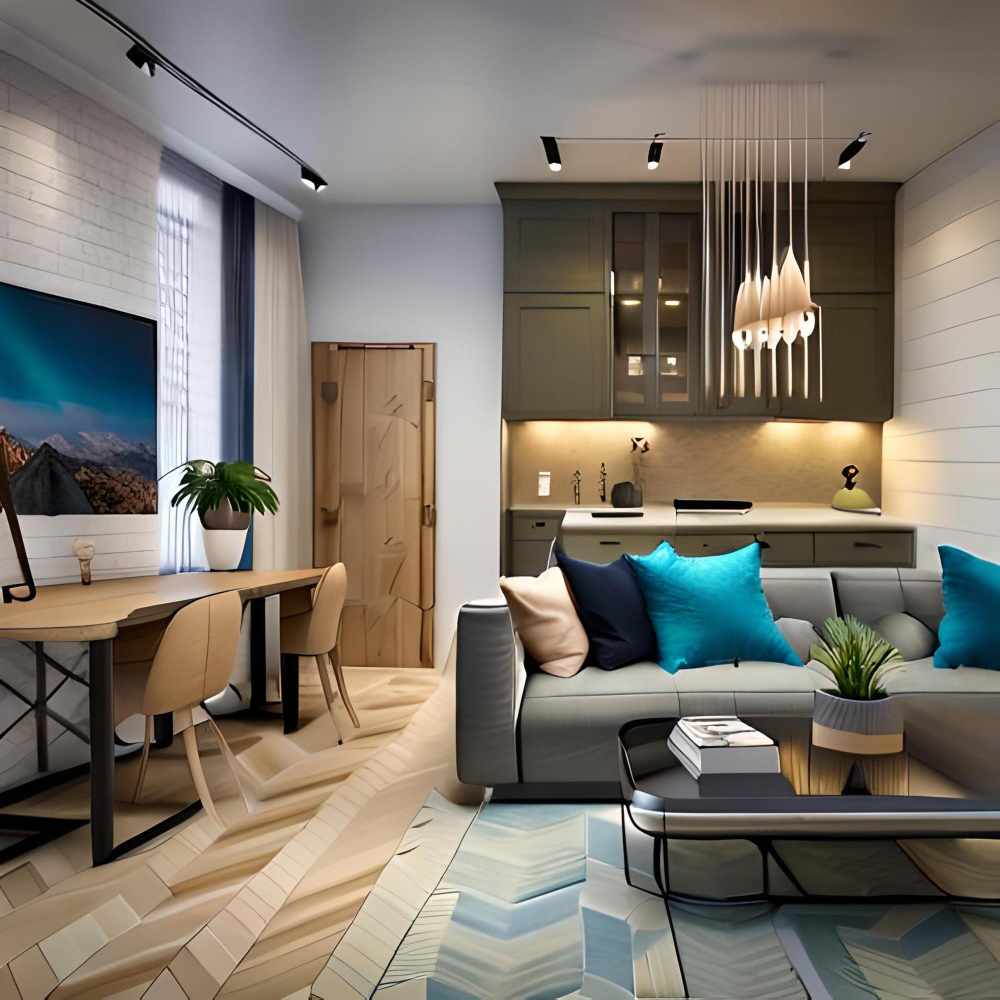From Pixels to Perception: Creating Emotionally Resonant Interior Renders

In today’s digitally-driven world, the art of interior rendering has emerged as a powerful tool in design. Gone are the days when architects and interior designers relied solely on sketches and blueprints to communicate their vision. With advanced software and technology, they can bring their ideas to life through visually stunning and emotionally resonant interior renders.
This article embarks on a captivating journey into the world of interior rendering, exploring how this art form has evolved and its profound impact on how we perceive and experience interior spaces. From the pixels on a computer screen to the emotions it evokes in viewers, we’ll delve deep into the process of creating internal renders that go beyond aesthetics and speak to the soul.
Discover more about the transformative power of interior rendering at YouSee Studio.
The Evolution of Interior Rendering
Before we dive into the intricacies of creating emotionally resonant interior renders, it’s crucial to understand how far this art form has come. The evolution of interior rendering is a testament to the relentless pursuit of realism and emotional connection in design visualization.
1. Hand-Drawn Renderings: A Glimpse of the Past
In the past, interior designers and architects relied heavily on hand-drawn renderings to convey their ideas. These renderings, created with pencils, pens, and watercolors, offered a glimpse into the designer’s imagination. While they possessed a certain charm, they often lacked the realism and precision that modern technology allows.
2. The Digital Revolution: A Paradigm Shift
The advent of computers and design software marked a turning point in interior rendering. Designers began to embrace digital tools, which allowed for greater accuracy and efficiency. Computer-generated renderings could depict materials, textures, and lighting conditions with remarkable realism, setting a new standard for the industry.
3. Photorealism: Blurring the Lines
As technology advanced, the pursuit of photorealism in interior rendering gained momentum. Designers and rendering artists aimed to create lifelike images that were indistinguishable from photographs. This quest for realism became a hallmark of modern interior rendering.
4. Beyond Aesthetics: The Emotional Impact
While photorealism was an impressive achievement, it was just the beginning. Designers recognized that interior rendering had the potential to do more than showcase aesthetics; it could evoke emotions and tell compelling stories. This realization marked a profound shift in conceptualizing and creating interior renders.
The Art of Emotion in Interior Rendering
1. The Power of Lighting
One critical element that contributes to an interior render’s emotional resonance is lighting. Lighting can set the mood, create drama, and highlight specific features within a space. Designers meticulously craft lighting scenarios that evoke the desired emotions in viewers.
- Natural Light: Simulating the gentle warmth of sunlight streaming through a window can create a sense of comfort and serenity.
- Dramatic Lighting: Dramatic shadows and contrasts can evoke suspense or intrigue, ideal for spaces like art galleries or upscale restaurants.
- Soft Ambient Light: Soft, diffused lighting can make a space feel cozy and inviting, making it well-suited for residential interiors.
2. Material Realism
The texture and materiality of surfaces within an interior play a significant role in conveying emotion. Modern rendering software allows for the meticulous recreation of materials, from the grain of wood to the sheen of metal.
- Warm Wood Tones: Using rich, natural wood textures can infuse a space with a sense of warmth and tradition.
- Sleek Metallic Finishes: Polished metals can render a contemporary and sophisticated feel, ideal for high-end retail spaces.
- Soft Fabrics: The depiction of smooth, tactile fabrics can make viewers imagine the comfort of lounging in a cozy chair, perfect for hospitality or residential interiors.
3. Composition and Framing
Much like a photographer composing a shot, interior render artists carefully consider the composition and framing of their scenes. The arrangement of objects and the choice of focal points can guide the viewer’s eye and elicit specific emotions.
- Symmetry: Symmetrical compositions can convey a sense of balance and order, often associated with classical and formal interiors.
- Asymmetry: An asymmetrical arrangement can create a dynamic and energetic atmosphere suitable for modern and eclectic spaces.
- Framing: Using architectural elements or furniture to frame a scene can draw attention to a focal point, intensifying the emotional impact.
4. Color Psychology
Color is a potent tool for evoking emotions in interior rendering. Designers harness the psychology of color to create renders that resonate with viewers on a visceral level.
- Cool Blues and Greens: These colors can impart calm and tranquility, making them ideal for spaces like bedrooms or spa interiors.
- Passionate Reds: Reds can stimulate excitement and energy, making them suitable for spaces where dynamism is desired, such as entertainment venues.
- Neutral Palettes: Neutral colors can evoke a timeless and sophisticated atmosphere, often seen in luxury interiors.
The Role of Technology in Emotional Rendering
1. Advanced Rendering Software
The development of advanced rendering software has been instrumental in achieving emotional resonance in interior renders. These programs offer features like global illumination, ray tracing, and material libraries that empower designers to create highly realistic and emotionally charged visuals.
2. Virtual Reality (VR) and Augmented Reality (AR)
VR and AR technologies have pushed the boundaries of emotional rendering even further. They allow clients and designers to immerse themselves in virtual spaces, experiencing the emotions a design evokes before it’s physically realized. This level of immersion has transformed the design and decision-making process.
3. Artificial Intelligence (AI)
AI algorithms are being employed to analyze vast design trends and user preferences datasets. This data-driven approach helps designers make choices that resonate with specific target audiences.
4. Real-time Rendering
Real-time rendering engines enable designers to make instantaneous adjustments and observe the emotional impact of those changes. This iterative process leads to emotionally resonant renders finely tuned to perfection.
The Ethical Dimension: Responsible Emotional Rendering
While pursuing emotional resonance in interior rendering is exciting, it comes with ethical considerations. Designers and rendering artists are responsible for ensuring that their work aligns with moral and cultural norms. This includes concerns related to inclusivity, cultural sensitivity, and sustainability.
- Inclusivity: Interior renders should represent diverse demographics to ensure everyone feels seen and described in the designed spaces.
- Cultural Sensitivity: Designers should be mindful of cultural symbols, motifs, and references, avoiding cultural appropriation or insensitivity.
- Sustainability: Responsible rendering should also convey environmentally friendly choices, emphasizing sustainable materials and practices.
Conclusion: The Art of Emotional Interior Rendering
The quest for emotional resonance has become a defining feature in the ever-evolving world of interior rendering. From the pixelated beginnings of computer-generated imagery to the immersive experiences of virtual reality, rendering has transcended its role as a mere visualization tool. It has become a conduit for evoking emotions, telling stories, and shaping how we perceive and interact with interior spaces.
As technology advances, rendering artists and designers find themselves at the intersection of art and science. They are not merely creating images; they are crafting emotional experiences. The future promises even more exciting possibilities, with AI-driven design, real-time rendering, and ethical considerations becoming integral to interior rendering.
In this journey from pixels to perception, interior renders cease to be static images on a screen. They become windows into emotions, inviting us to imagine, feel, and connect with the spaces they represent. The evolution continues, and the feelings linger, making interior rendering a profound and transformative art form.
The Creative Process Behind Emotional Interior Rendering
Emotional interior rendering is an art that combines technology, design, and psychology. To delve deeper into this captivating realm, we must understand the creative process that brings emotionally resonant renders to life. In this part of our exploration, we’ll uncover the steps, techniques, and strategies designers and artists employ to craft interior renders that evoke powerful emotions.
Step 1: Conceptualization and Inspiration
Every emotional interior render begins with a vision. Designers and artists draw inspiration from various sources to conceptualize the essence of a space. Here’s how they do it:
1.1 Immersive Research
- Historical Periods: Exploring different periods allows designers to infuse authenticity and nostalgia into their renders.
- Cultural References: Drawing inspiration from diverse cultures enriches the design with meaningful symbols and motifs.
- Nature and Environment: The natural world often serves as a wellspring of inspiration, influencing color palettes, materials, and textures.
- Art Movements: Borrowing elements from renowned art movements, such as Art Deco or Minimalism, can add depth and character to a render.
1.2 Emotional Analysis
Designers analyze the emotions they aim to evoke in viewers. Different spaces call for distinct emotional responses; this analysis guides design choices.
- Comfort and Relaxation: Residential spaces often aim for feelings of comfort and relaxation.
- Excitement and Engagement: Commercial spaces may seek to engage and excite visitors.
- Reflection and Contemplation: Spaces designed for meditation or introspection aim to induce reflective moods.
Step 2: Storytelling Through Design
Once the concept is established, it’s time to weave a compelling narrative into the design. The critical elements of storytelling in emotional interior rendering include:
2.1 Spatial Arrangement
Designers consider the flow of space, room layouts, and the arrangement of furniture and objects. Each element contributes to the narrative and emotion of the area.
- Open Spaces: An open layout can create feelings of freedom and inclusivity.
- Intimate Spaces: Smaller, cozy arrangements can evoke warmth and intimacy.
2.2 Materials and Textures
Materials are chosen with care to align with the emotional context of the space.
- Wood: Warm, natural wood textures can evoke a sense of rustic comfort.
- Glass and Metal: Sleek, reflective surfaces convey a modern, sophisticated ambiance.
2.3 Color Palette
Color psychology plays a pivotal role in emotional rendering. Designers select colors that resonate with the intended emotions.
- Cool Blues: Calm and tranquility
- Earthy Tones: Grounding and comfort
- Bold Reds: Passion and energy
2.4 Lighting Scenarios
The choice of lighting significantly impacts the emotional resonance of a render.
- Natural Light: Soft, diffused sunlight can create a tranquil atmosphere.
- Artificial Lighting: Strategically placed lights can highlight critical elements and create drama.
Step 3: Digital Craftsmanship
With the conceptual foundation laid, designers and artists turn to digital tools to bring their vision to life. Here’s how they do it:
3.1 3D Modeling
Designers create a three-dimensional digital model of the space. This includes all objects, furniture, and architectural elements. Advanced 3D modeling software allows for meticulous detailing.
3.2 Texturing and Material Mapping
Each surface in the 3D model is assigned appropriate textures and materials. This step is crucial for achieving realism. Materials are selected based on the emotional context of the space.
3.3 Lighting Simulation
Designers set up lighting scenarios within the 3D modeling software. They carefully adjust parameters like light intensity, color temperature, and angle to create the desired ambiance.
3.4 Rendering Engines
Rendering engines like V-Ray, Lumion, or Corona Renderer transform the 3D model into a lifelike image. These engines calculate how light interacts with materials and textures to produce a final image.
Step 4: Post-Processing and Fine-Tuning
While rendering engines can produce impressive results, artists often engage in post-processing to enhance the emotional impact of their renders.
4.1 Color Correction
Subtle color adjustments can align the render with the desired emotional tone.
4.2 Composition Enhancements
Artists may use post-processing to refine the composition, emphasizing focal points and framing.
4.3 Effects and Filters
Various digital effects and filters can be applied to create specific moods or atmospheres.
Step 5: Feedback and Iteration
Emotionally resonant interior rendering is a collaborative process. Designers and artists often seek peer, client, or focus group feedback. This feedback loop allows for refinement and iteration to ensure the render effectively conveys the intended emotions.
Step 6: Presentation and Visualization
Once the render is complete, it’s time to share it with clients, stakeholders, or the public. Visualization techniques play a pivotal role in conveying emotions:
6.1 Virtual Reality (VR)
VR allows viewers to immerse themselves in the render, experiencing the emotions firsthand. It’s precious for architects and designers seeking to showcase their designs to clients.
6.2 Augmented Reality (AR)
AR apps enable viewers to superimpose a render onto the physical space, offering a novel way to experience the emotional impact of a design.
Step 7: Evoking Emotion in Viewers
The ultimate measure of success in emotional interior rendering is viewers’ emotional response. Here are some of the ways designers and artists aim to evoke emotions:
7.1 Storytelling Elements
Viewers connect emotionally when they perceive a narrative within the render. This narrative can be subtle, like the story of a cozy reading nook, or explicit, like the tale of a bustling café.
7.2 Attention to Detail
Meticulous attention to detail, such as a well-worn leather armchair or a rain-spattered window, can transport viewers into the render, eliciting memories and emotions.
7.3 Lighting as Emotion
Lighting is a powerful tool for conveying emotions. The soft glow of a bedside lamp can evoke feelings of comfort and security, while the harsh glare of neon lights may elicit tension.
Step 8: Ethical Considerations
As designers strive to evoke emotions through rendering, ethical considerations are paramount. Here are some ethical guidelines in emotional rendering:
8.1 Diversity and Inclusivity
Designers must ensure that their renders represent a diverse range of people to foster inclusivity.
8.2 Cultural Sensitivity
Avoiding cultural stereotypes and respecting diverse cultural backgrounds is essential.
8.3 Sustainability
Emotionally resonant rendering should also promote sustainability, reflecting responsible design choices.
In conclusion, emotional interior rendering is a multi-faceted journey combining artistic vision, technological prowess, and ethical responsibility. From the initial spark of inspiration to the presentation of the final render, every step in the creative process aims to stir emotions and tell stories through design. As technology advances, the possibilities for emotional rendering are expanding, promising even more immersive and evocative experiences for viewers. Interior renders are no longer static images; they are gateways to emotions and narratives, inviting us to explore, feel, and connect with the spaces they depict. The evolution of emotional interior rendering is a testament to the power of design in shaping our emotional responses to the world around us.

How Advanced Freight Broker Software Shapes a Profitable, Productive Supply Chain

How a Poor Internet Connection Can Hamper Your Business

The Ultimate Way to Stay Organized at Your Nail Salon

AI in Marketing Is No Longer a Buzzword — It’s the Strategy

Srinivasa Rao Challa Champions AI-Powered Financial Systems for a Smarter, Safer Economy

How to Plan the Perfect Pet-Friendly Yard

Home Security System Providers in Phoenix

Top Materials For Durable And Stylish Doors And Windows








